A motorbike exhaust note is like your bike’s voice.
You don’t need it to let out a deafening roar every time you turn the key.
But you also don’t want it to whisper so quietly you can barely hear it.
I reckon a strong rumbling purr is the ideal.
When we finally got our hands on our new Indian Scout, we knew she’d look amazing.
But we really wondered how she’d sound.
Pat fired her up for the first time … and … hmm.
She mumbled away in a boring murmur that had no personality at all.
We rode her for a little while, and nothing changed.
Right. We need a better motorbike exhaust, said Pat, heading for the internet with his credit card already out.
A couple of weeks later, the solution arrived at the back door in a big cardboard box…
Fishtails!
This Bassani motorbike exhaust was one of the first on the market for the new Indian Scout.
Just take a look at the difference.
From this:
To this:
Perfect for a bike with old-school styling.
And that Bassani motorbike exhaust is not just beautiful to look at.
The Bassani fishtails weigh a little under 4 kg.
The standard Indian Scout pipes were 10 kg!
All that catalytic converter material weighs a tonne (and silences the bike).
Losing 6 kg was a positive change that’s almost as obvious as the gorgeous new look.
So the Bassani motorbike exhaust was stunning, for sure.
But now we had a new problem.
The Fishtails Were SUPER Loud!
With this motorbike exhaust system, the bike sounded like we were clinging to the mane of a crazed wild lion as he tore through the streets.
We’d start it up in the driveway at home, and the neighbors would come to see if we’d opened our own wildlife park.
They would laugh and shake their heads.
But they’re used to us, and have their own gas-fuelled beasts.
It was a little trickier taking the Indian Scout OUT of the wildlife park and onto the local roads.
Start her up outside the local mall, and those fishtails would cause widespread panic:
- Gaggles of teenage girls would leap into the air, shrieking
- Babies would wake up, and start to wail
- Middle-aged couples would glare and “tut tut” at this crass disturbance of the peace.
Only the old ladies would smile approvingly.
For the first time in years, they could suddenly hear something – loud and clear.
It was pretty obvious we’d have to do something before the local police started getting reports of a wild lion loose in the suburbs.
How We Made That Bassani Motorbike Exhaust Purr Instead of Roar
Motorcycle baffles would have to be found.
First we tried buying baffles online.
They took ages to get here, and then they didn’t fit.
So we tried the ole rolled-up-chicken-wire trick, but the Indian Scout blew those out with a snort on the first ride.
Clearly, we’d have to take matters into our own hands.
And so we spent a cosy afternoon out in the garage making our own motorcycle baffles. Here’s how we did it.
1. Remove the fishtails.
This was quick and easy as the Bassani motorcycle exhaust is connected by one accessible bolt and two exhaust clamps.
2. Make some DIY motorcycle baffles.
We got some steel pipe from the local hardware store, and welded a washer to one end so it would stay in place inside the fishtails.
Then Pat drilled holes in the pipe itself so the air can still move freely enough.
3. Insulate the baffles.
Pat wrapped the drilled pipe length with heat resistant steel wool (Adrenaline R 430 grade stainless wool) to add another layer of muffling that would still allow airflow. He attached the steel wool with a thin piece of wire which kept the whole thing in place.
4. Re-attach the fishtails.
We twisted our brand new motorcycle baffles into the Bassani motorcycle exhaust a little at a time; it was quite a tight fit.
Then it was just a matter of bolting the fishtails back on.
Perfect!
It’s been a few months now, and our home made motorcycle baffles are still in place.
And the Indian Scout no longer sounds like a wounded lion crashing through the jungle roaring at the top of his lungs.
But we haven’t tamed the Bassani motorcycle exhaust altogether.
The bike growls along nicely.
It still has teeth and claws – without sounding like a maddened beast out for blood.
Like this article?
You might like this, too:
Touring New Zealand by Motorcycle? Good Luck Ordering Dinner!


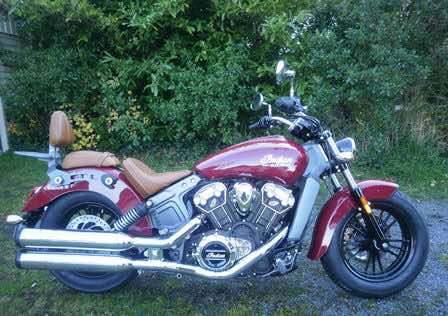
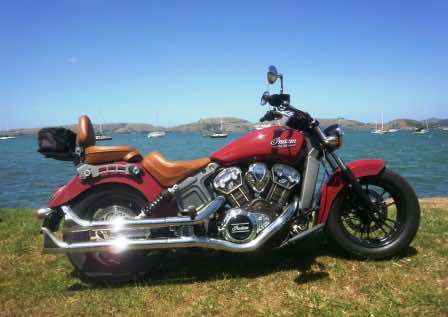
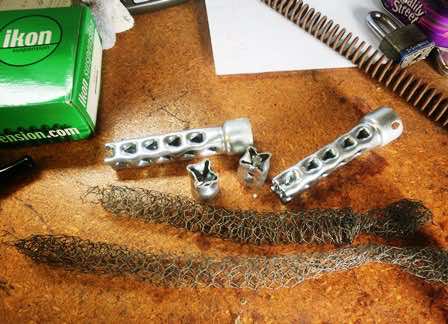
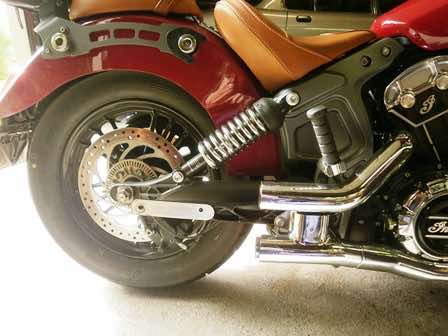

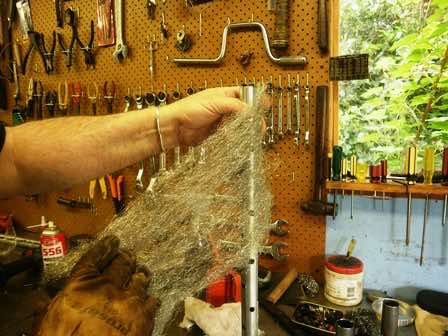
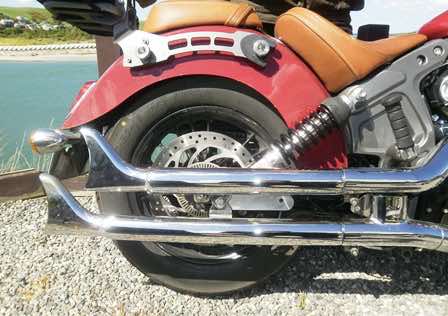




I like your article lis.wonderfull
Thanks, Agus! Appreciate the feedback. 🙂
Hi Liz, those fishtails look absolutely magnificent, but I can’t hear them! Do you have a sound-clip or a YouTube video I could access? There are probably a lot of other riders who want to hear the roar of your lion too.
Thanks, Irvine! I reckon they look 100% better too. I don’t have a sound clip, I’m afraid – sorry! I’ll add that to my list..
I had to do the same to my night rod! Nice Scout, by the way
Hope it worked for you, Guillermo! We had to get the Scout in that red, she’s irresistible!
Great article – just proves that mechanical stuff can be fun. And, as I always say, “Couples that adjust their baffles together stay together” ……
Thanks, Julie – I never used to go anywhere near the garage, but I’ve learned how much fun you can have out there!
How did you keep the baffles tight inside the fishtails? Did they extend all the way to the end of the muffler where the fishtail shape starts? I am very interested in the particulars as I just spent $500 on a set of 36″ fishtails for my Road King and do not like how loud they are at all…. Thank you!
Yes, fishtails are LOUD! We wrapped chicken wire around the baffle (but some kind of mesh wire would do, perhaps even screen door type of stuff) and then wrapped Adrenaline R430 grade stainless wool around it, laced on with fine wire and twisted a bit so the whole lash-up could be wound into the pipes from the front end. The washer welded to the end of the baffle pipe stops the whole thing from blowing out the back (so far, anyway). We’re still experimenting with this, as the pipes are still a bit too loud for our taste. We made sure the baffle doesn’t stick out the back of the fishtail or into view, so we cut them accordingly. But ours are home made baffles, not sure if you’re buying ready made ones…
Hi Liz,
Great article, nice to read. And the new exhaust pipes really are an improvement.
Thanks, Chris! The new pipes are much better suited to the style of the bike I think. Appreciate your comment.
Do the fishtails allow you to put on factory saddlebags
Hmm, not sure about that, John; we got a little brown leather one custom made; your dealer should be able to tell you hopefully?
My 1700CC Roadstar that has 3″ Chrome Long shots on it could use this treatment. 🙂
Must be getting old… lol
Hehehe, nothing wrong with wanting to purr, Karl! 😉
Hi there it’s me, I am also visiting this site regularly,
this web site is really good and the visitors are really sharing good thoughts.
Thanks for your lovely feedback, Myles!
As a 31-year veteran of the Houston PD who has probably cited and incarcerated more operators of illegally LOUD motorcycles, auto’s and trucks than most officers in the United States, I wanted to respond to the Twitter question that provided the URL to this article – “Can a motorcycle be too loud?”
My answer,
“Can a motorcycle be too loud?” – yes…any exhaust, especially an aftermarket exhaust that emits sound greater than the factory-installed muffler is too LOUD! The factory-installed, US EPA approved muffler is the “objective” standard when evaluating noise emissions – unfortunately, an overwhelming number of our law enforcement personnel in the United States are too ignorant of the law, too apathetic, too participatory to actually enforce the law: hence, the out-of-control, illegal, motorcycle, auto and truck noise on our public roadways.
The US EPA, though they’ve recently sued Harley for $15 mil. relevant to their illegal “super tuners,” the EPA is too apathetic to regulate the illegal, criminally conspiratorial marketing strategies of the Motorcycle Aftermarket Exhaust Industry who discreetly manufacture NOT FOR ROAD USE – CLOSED COURSE ONLY – RACING ENVIRONS ONLY exhausts for street-ready motorcycles…like those Bassani slip-0ns mentioned in the article above.
It only stands to reason that if…after extensive testing and evaluation, the “minimum” level of “total” motorcycle noise emissions protection for the general public is 80 dB(A)…a muffler or exhaust that emits noise greater than the factory-installed muffler is too loud and therefore emitting “excessive or unusual noise.”
Questions? Please see my video and my articles on this subject at:
Loud Motorcycles? THE LAW: https://www.youtube.com/watch?v=ouBsdUq-2Iw&t=302s
Article: The Truth about Loud Motorcycles the Police Won’t or Can’t Tell You: https://rickeyholtsclaw.wordpress.com/2016/03/10/the-truth-about-loud-motorcycles-the-police-wont-or-cant-tell-you/
Article: Motorcycle Noise Enforcement – 101: https://rickeyholtsclaw.wordpress.com/2016/09/12/motorcycle-noise-enforcement-101/
You have a beautiful Website….very professional!
Rick Holtsclaw, Houston PD/Retired
Concerned Citizens Against Loud Motorcycles – Facebook, YouTube and WordPress
Thanks for your passionate and detailed comment, Rickey. It’s always interesting to see a range of views. I appreciate the time you’ve taken to explain some of the legislation which applies in the US – as this is a New Zealand based blog and has readers from all over the world, I have edited some of of the specifics on the legislation to ensure relevance to my audience. Interested readers should see the links at the end of Rickey’s comment for more info.
Hmmmm…..looked everywhere for what were used in the 60s. Had them on my Honda 250 scrambler.
Hole through the pipe….near the end
The device was basically a a washer slightly smaller in diameter than the pipe I.D.
Welded 180 degrees on each side of the “washer,” were the end of a split threaded rod.
Picture it inserted in the end of the pipe….stiff coil spring on one side, with lock nut holding it. Other end the same, but with a “nail” through it….the nail is designed to ride over two smooth stops….lock nut on this end of rod too.
Twist to make washer flat= loud…twist with washer perpendicular…..sound seriously muffled.
Maybe out here somewhere, someone still makes them. A cleaver DIYer could do it.
Interesting! Yep, if you had the bits and pieces (and the patience) you could probably pull this off. Thanks for the suggestion!
On a fuel injection bike is it necessary to re map the computer?
Hey Joe, I talked to Pat about this and he pointed out that we’ve done similar stuff to a couple of different bikes with no problems. Changing up minor stuff like this doesn’t seem to need re-mapping the computer; the bike seems to adjust to the change without a problem. 🙂